2019 Hyundai Ioniq Electric climate control
[x] Cancel search: climate controlPage 416 of 555
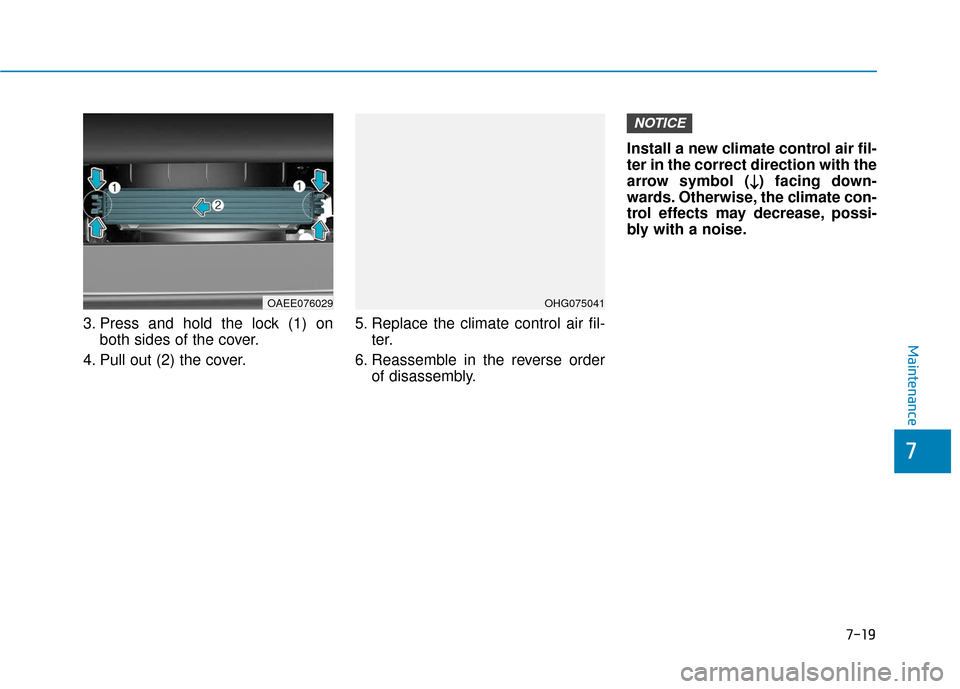
7-19
7
Maintenance
3. Press and hold the lock (1) onboth sides of the cover.
4. Pull out (2) the cover. 5. Replace the climate control air fil-
ter.
6. Reassemble in the reverse order of disassembly. Install a new climate control air fil-
ter in the correct direction with the
arrow symbol (
↓ ↓) facing down-
wards. Otherwise, the climate con-
trol effects may decrease, possi-
bly with a noise.
NOTICE
OHG075041OAEE076029
Page 422 of 555
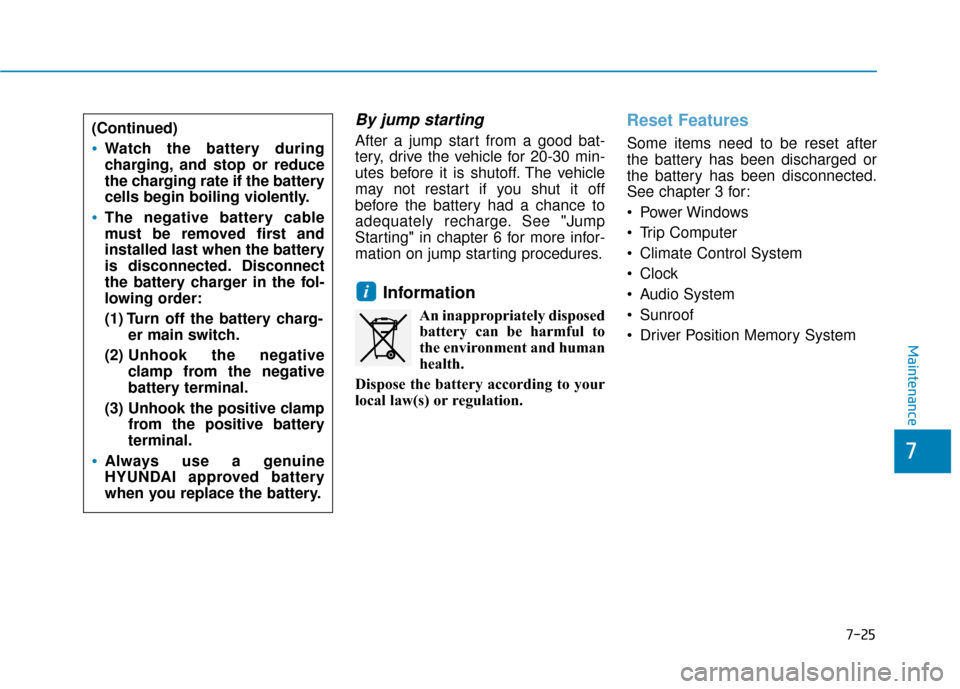
7-25
7
Maintenance
By jump starting
After a jump start from a good bat-
tery, drive the vehicle for 20-30 min-
utes before it is shutoff. The vehicle
may not restart if you shut it off
before the battery had a chance to
adequately recharge. See "Jump
Starting" in chapter 6 for more infor-
mation on jump starting procedures.
Information
An inappropriately disposedbattery can be harmful to
the environment and human
health.
Dispose the battery according to your
local law(s) or regulation.
Reset Features
Some items need to be reset after
the battery has been discharged or
the battery has been disconnected.
See chapter 3 for:
Power Windows
Trip Computer
Climate Control System
Clock
Audio System
Sunroof
Driver Position Memory System
i
(Continued)
Watch the battery during
charging, and stop or reduce
the charging rate if the battery
cells begin boiling violently.
The negative battery cable
must be removed first and
installed last when the battery
is disconnected. Disconnect
the battery charger in the fol-
lowing order:
(1) Turn off the battery charg- er main switch.
(2) Unhook the negative
clamp from the negative
battery terminal.
(3) Unhook the positive clamp from the positive battery
terminal.
Always use a genuine
HYUNDAI approved battery
when you replace the battery.
Page 428 of 555
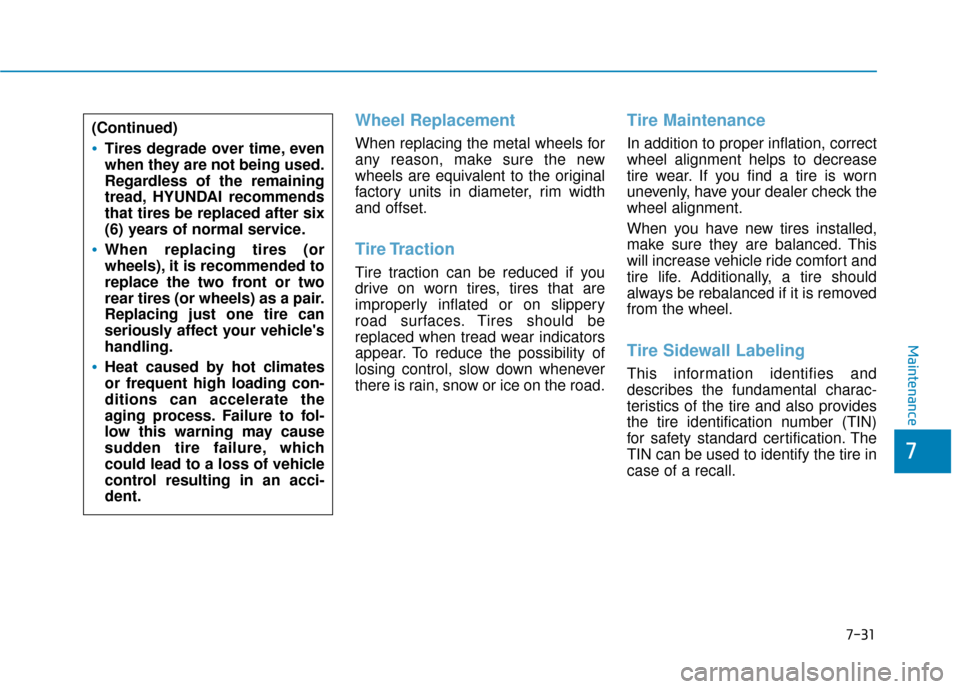
7-31
7
Maintenance
Wheel Replacement
When replacing the metal wheels for
any reason, make sure the new
wheels are equivalent to the original
factory units in diameter, rim width
and offset.
Tire Traction
Tire traction can be reduced if you
drive on worn tires, tires that are
improperly inflated or on slippery
road surfaces. Tires should be
replaced when tread wear indicators
appear. To reduce the possibility of
losing control, slow down whenever
there is rain, snow or ice on the road.
Tire Maintenance
In addition to proper inflation, correct
wheel alignment helps to decrease
tire wear. If you find a tire is worn
unevenly, have your dealer check the
wheel alignment.
When you have new tires installed,
make sure they are balanced. This
will increase vehicle ride comfort and
tire life. Additionally, a tire should
always be rebalanced if it is removed
from the wheel.
Tire Sidewall Labeling
This information identifies and
describes the fundamental charac-
teristics of the tire and also provides
the tire identification number (TIN)
for safety standard certification. The
TIN can be used to identify the tire in
case of a recall.
(Continued)
Tires degrade over time, even
when they are not being used.
Regardless of the remaining
tread, HYUNDAI recommends
that tires be replaced after six
(6) years of normal service.
When replacing tires (or
wheels), it is recommended to
replace the two front or two
rear tires (or wheels) as a pair.
Replacing just one tire can
seriously affect your vehicle's
handling.
Heat caused by hot climates
or frequent high loading con-
ditions can accelerate the
aging process. Failure to fol-
low this warning may cause
sudden tire failure, which
could lead to a loss of vehicle
control resulting in an acci-
dent.
Page 431 of 555
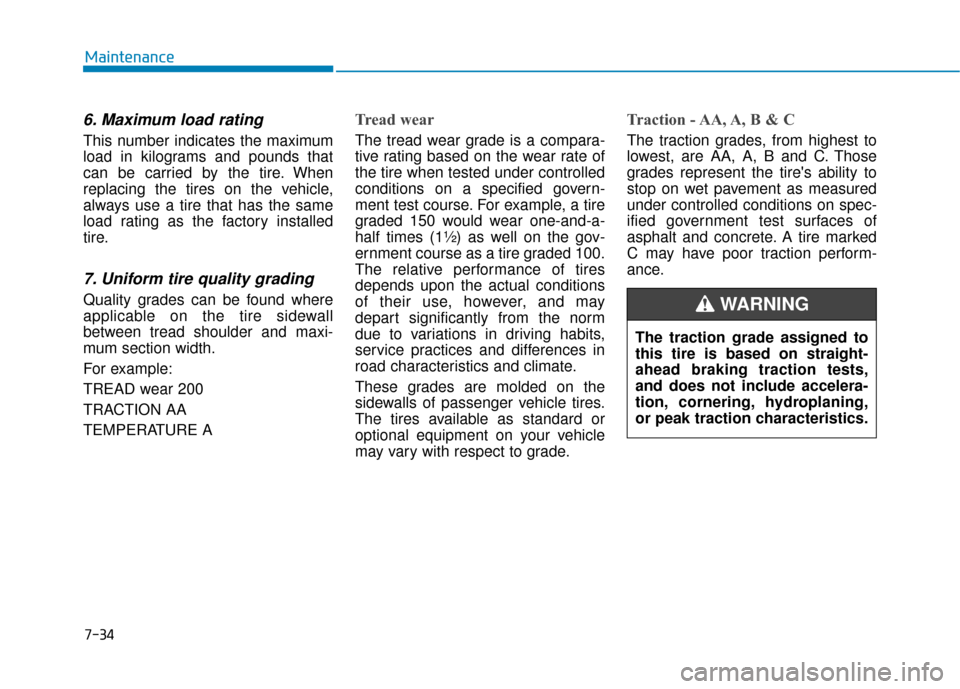
7-34
Maintenance
6. Maximum load rating
This number indicates the maximum
load in kilograms and pounds that
can be carried by the tire. When
replacing the tires on the vehicle,
always use a tire that has the same
load rating as the factory installed
tire.
7. Uniform tire quality grading
Quality grades can be found where
applicable on the tire sidewall
between tread shoulder and maxi-
mum section width.
For example:
TREAD wear 200
TRACTION AA
TEMPERATURE A
Tread wear
The tread wear grade is a compara-
tive rating based on the wear rate of
the tire when tested under controlled
conditions on a specified govern-
ment test course. For example, a tire
graded 150 would wear one-and-a-
half times (1½) as well on the gov-
ernment course as a tire graded 100.
The relative performance of tires
depends upon the actual conditions
of their use, however, and may
depart significantly from the norm
due to variations in driving habits,
service practices and differences in
road characteristics and climate.
These grades are molded on the
sidewalls of passenger vehicle tires.
The tires available as standard or
optional equipment on your vehicle
may vary with respect to grade.
Traction - AA, A, B & C
The traction grades, from highest to
lowest, are AA, A, B and C. Those
grades represent the tire's ability to
stop on wet pavement as measured
under controlled conditions on spec-
ified government test surfaces of
asphalt and concrete. A tire marked
C may have poor traction perform-
ance.The traction grade assigned to
this tire is based on straight-
ahead braking traction tests,
and does not include accelera-
tion, cornering, hydroplaning,
or peak traction characteristics.
WARNING
Page 481 of 555
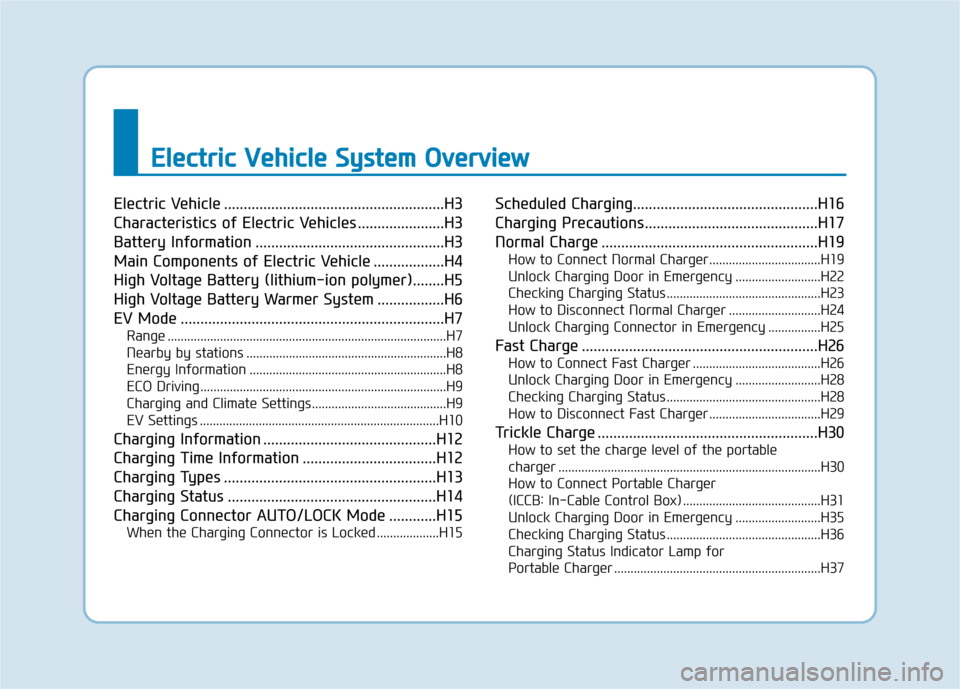
E
El
le
e c
ct
tr
r i
ic
c
V
V e
eh
h i
ic
c l
le
e
S
S y
ys
st
te
e m
m
O
O v
ve
e r
rv
v i
ie
e w
w
Electric Vehicle ........................................................H3
Characteristics of Electric Vehicles ......................H3
Battery Information ................................................H3
Main Components of Electric Vehicle ..................H4
High Voltage Battery (lithium-ion polymer)........H5
High Voltage Battery Warmer System .................H6
EV Mode ...................................................................H7
Range ........................................................................\
.............H7
Nearby by stations .............................................................H8
Energy Information ............................................................H8
ECO Driving ........................................................................\
...H9
Charging and Climate Settings.........................................H9
EV Settings ........................................................................\
.H10
Charging Information ............................................H12
Charging Time Information ..................................H12
Charging Types ......................................................H13
Charging Status .....................................................H14
Charging Connector AUTO/LOCK Mode ............H15
When the Charging Connector is Locked ...................H15
Scheduled Charging...............................................H16
Charging Precautions............................................H17
Normal Charge .......................................................H19
How to Connect Normal Charger..................................H19
Unlock Charging Door in Emergency ..........................H22
Checking Charging Status ...............................................H23
How to Disconnect Normal Charger ............................H24
Unlock Charging Connector in Emergency ................H25
Fast Charge ............................................................H26
How to Connect Fast Charger .......................................H26
Unlock Charging Door in Emergency ..........................H28
Checking Charging Status ...............................................H28
How to Disconnect Fast Charger ..................................H29
Trickle Charge ........................................................H30
How to set the charge level of the portable
charger ........................................................................\
........H30
How to Connect Portable Charger
(ICCB: In-Cable Control Box) ..........................................H31
Unlock Charging Door in Emergency ..........................H35
Checking Charging Status ...............................................H36
Charging Status Indicator Lamp for
Portable Charger ...............................................................H37
Page 489 of 555
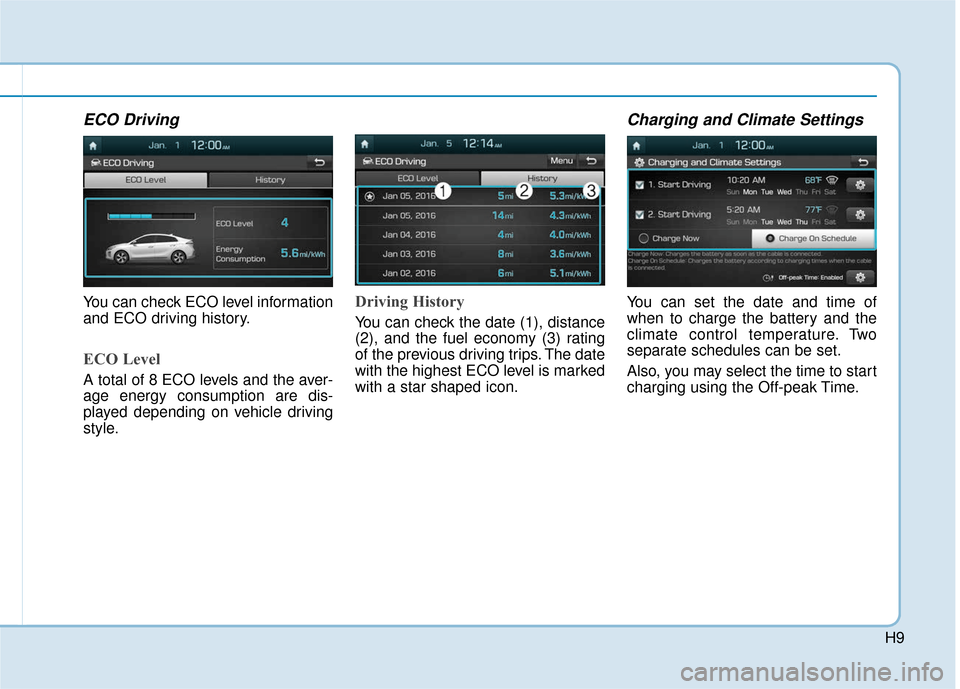
H9
ECO Driving
You can check ECO level information
and ECO driving history.
ECO Level
A total of 8 ECO levels and the aver-
age energy consumption are dis-
played depending on vehicle driving
style.
Driving History
You can check the date (1), distance
(2), and the fuel economy (3) rating
of the previous driving trips. The date
with the highest ECO level is marked
with a star shaped icon.
Charging and Climate Settings
You can set the date and time of
when to charge the battery and the
climate control temperature. Two
separate schedules can be set.
Also, you may select the time to start
charging using the Off-peak Time.
Page 543 of 555
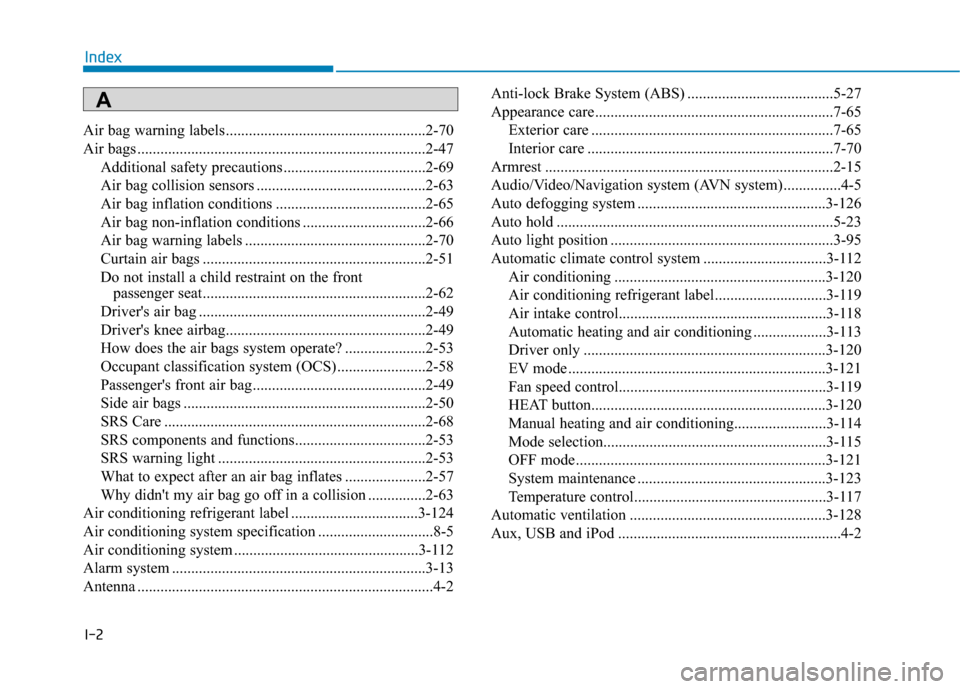
I-2
Air bag warning labels ....................................................2-70
Air bags ........................................................................\
...2-47Additional safety precautions .....................................2-69
Air bag collision sensors ............................................2-63
Air bag inflation conditions .......................................2-65
Air bag non-inflation conditions ................................2-66
Air bag warning labels ...............................................2-70
Curtain air bags ..........................................................2-51
Do not install a child restraint on the front passenger seat..........................................................2-62
Driver's air bag ...........................................................2-49
Driver's knee airbag....................................................2-49
How does the air bags system operate? .....................2-53
Occupant classification system (OCS) .......................2-58
Passenger's front air bag.............................................2-49
Side air bags ...............................................................2-50
SRS Care ....................................................................2-68\
SRS components and functions..................................2-53
SRS warning light ......................................................2-53
What to expect after an air bag inflates .....................2-57
Why didn't my air bag go off in a collision ...............2-63
Air conditioning refrigerant label .................................3-124
Air conditioning system specification ..............................8-5
Air conditioning system ................................................3-112
Alarm system ..................................................................3-13
Antenna ........................................................................\
.....4-2 Anti-lock Brake System (ABS) ......................................5-27
Appearance care..............................................................7-65
Exterior care ...............................................................7-65
Interior care ................................................................7-70
Armrest ........................................................................\
...2-15
Audio/Video/Navigation system (AVN system)...............4-5
Auto defogging system .................................................3-126
Auto hold ........................................................................\
5-23
Auto light position ..........................................................3-95
Automatic climate control system ................................3-112 Air conditioning .......................................................3-120
Air conditioning refrigerant label.............................3-119
Air intake control......................................................3-118
Automatic heating and air conditioning ...................3-113
Driver only ...............................................................3-120
EV mode ...................................................................3-121\
Fan speed control......................................................3-119
HEAT button.............................................................3-120
Manual heating and air conditioning........................3-114
Mode selection..........................................................\
3-115
OFF mode.................................................................3-121
System maintenance .................................................3-123
Temperature control..................................................3-117
Automatic ventilation ...................................................3-128
Aux, USB and iPod ..........................................................4-2
Index
A
Page 545 of 555
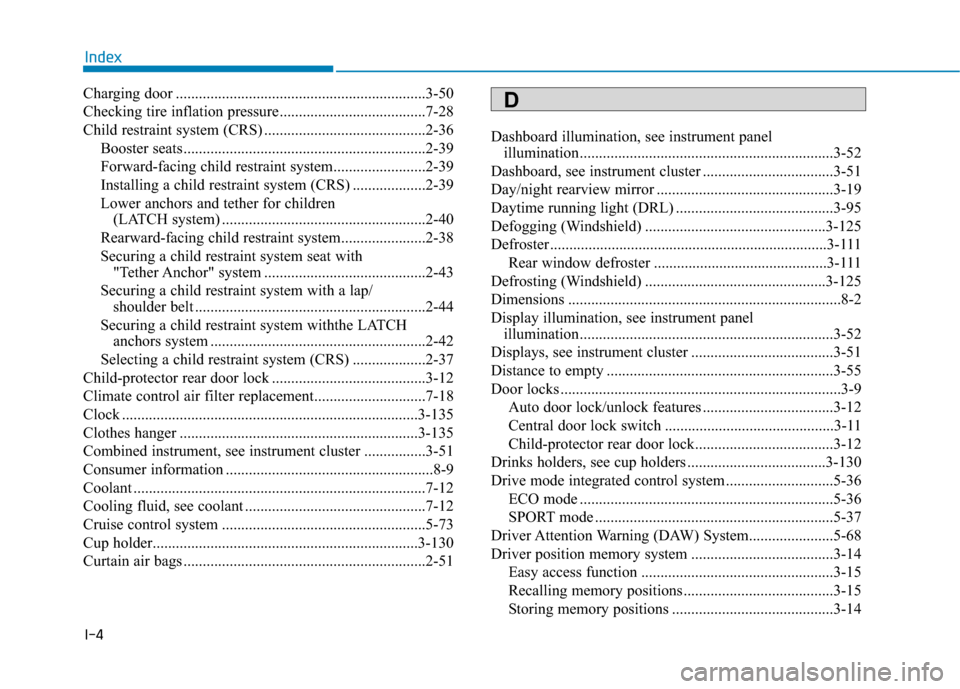
I-4
Charging door .................................................................3-50
Checking tire inflation pressure ......................................7-28
Child restraint system (CRS) ..........................................2-36Booster seats...............................................................2-39
Forward-facing child restraint system........................2-39
Installing a child restraint system (CRS) ...................2-39
Lower anchors and tether for children (LATCH system) .....................................................2-40
Rearward-facing child restraint system......................2-38
Securing a child restraint system seat with "Tether Anchor" system ..........................................2-43
Securing a child restraint system with a lap/ shoulder belt ............................................................2-44
Securing a child restraint system withthe LATCH anchors system ........................................................2-42
Selecting a child restraint system (CRS) ...................2-37
Child-protector rear door lock ........................................3-12
Climate control air filter replacement.............................7-18
Clock ........................................................................\
.....3-135
Clothes hanger ..............................................................3-135
Combined instrument, see instrument cluster ................3-51
Consumer information ......................................................8-9
Coolant ........................................................................\
....7-12
Cooling fluid, see coolant ...............................................7-12
Cruise control system .....................................................5-73
Cup holder.....................................................................3-1\
30
Curtain air bags ...............................................................2-51 Dashboard illumination, see instrument panel
illumination..................................................................3-52
Dashboard, see instrument cluster ..................................3-51
Day/night rearview mirror ..............................................3-19
Daytime running light (DRL) .........................................3-95
Defogging (Windshield) ...............................................3-125
Defroster ........................................................................\
3-111 Rear window defroster .............................................3-111
Defrosting (Windshield) ...............................................3-125
Dimensions .......................................................................8\
-2
Display illumination, see instrument panel illumination..................................................................3-52
Displays, see instrument cluster .....................................3-51
Distance to empty ...........................................................3-55
Door locks ........................................................................\
.3-9 Auto door lock/unlock features ..................................3-12
Central door lock switch ............................................3-11
Child-protector rear door lock....................................3-12
Drinks holders, see cup holders ....................................3-130
Drive mode integrated control system ............................5-36 ECO mode ..................................................................5-36
SPORT mode ..............................................................5-37
Driver Attention Warning (DAW) System......................5-68
Driver position memory system .....................................3-14 Easy access function ..................................................3-15
Recalling memory positions .......................................3-15
Storing memory positions ..........................................3-14
Index
D